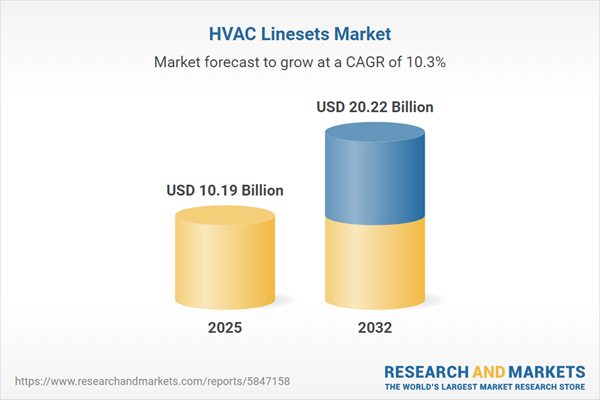Speak directly to the analyst to clarify any post sales queries you may have.
The HVAC linesets market is experiencing transformative change as industry shifts—driven by sustainability, regulatory standards, and advancing technologies—reshape investment priorities. Executives aiming to safeguard operational continuity and identify new growth avenues must align strategies to meet the evolving conditions that define this essential supply segment.
Market Snapshot: Trends Driving the HVAC Linesets Market
Demonstrating a notable compound annual growth rate, the HVAC linesets market is accelerating in commercial, industrial, and residential construction worldwide. Market expansion is fueled by more rigorous energy efficiency standards and emerging insulation mandates, which propel demand for linesets capable of supporting sustainable refrigerants and modern system retrofits. Executives are responding to the interplay of compliance pressures and sustainability by prioritizing durable solutions that can meet the demands of increasingly complex building initiatives. As energy and materials policies continue to evolve, these forces converge to shape strategic decision-making throughout the sector.
Scope & Segmentation: Comprehensive Overview of the HVAC Linesets Market
- Application Areas: Linesets serve climate control, refrigeration, and heat pump installations in commercial, industrial, retail, and multifamily residential environments, influencing both operational efficiency and indoor comfort standards.
- Material Types: Aluminum, copper, and stainless steel linesets each offer targeted advantages. Material selection is closely tied to project goals, compliance status, and the desired balance of durability and thermal performance.
- End User Profiles: Real estate, hospitality, pharmaceuticals, and retail organizations rely on lineset technology for uninterrupted climate management and to maximize building value, often requiring custom-engineered system approaches.
- Insulation Categories: Advanced materials such as aerogel, phenolic foam, polyurethane foam, EPDM rubber, and NBR rubber enhance performance, support compliance, and guard against moisture infiltration across diverse installation scenarios.
- Distribution Channels: Direct manufacturer deals, distribution partners, and wholesaler networks provide sourcing flexibility that helps match rapidly shifting project timelines and requirements.
- Regional Coverage: Active industry hubs span the Americas, Europe, Asia-Pacific, and Middle East & Africa. Regulatory leadership from the United States, Germany, China, and India significantly influences global best practices and compliance strategies.
- Technology Use: Digitally-enabled monitoring, sensor integration, and analytics platforms allow for condition tracking and maintenance optimization on an international scale, improving reliability in distributed portfolios.
- Profiled Companies: Leading suppliers—Mueller Industries, Wieland-Werke, KME Group, Hindalco, Parker-Hannifin, Johnson Controls, Carrier, Emerson, DiversiTech, and Danfoss—advance system integration, product development, and scalable supply models.
Key Takeaways for Senior Decision-Makers
- Selecting the right lineset specification mitigates operational risks and ensures consistent HVAC and refrigeration performance for business-critical environments.
- Implementing sustainable insulation and material advances supports ESG benchmarking and fosters resilience to future regulatory shifts.
- Digital monitoring with predictive analytics enables early detection of issues, lengthens asset life, and supports cost-effective management of expansive property assets.
- Adapting quickly to regulatory changes encourages sourcing from a broader supplier base and drives adoption of corrosion-resistant solutions to reduce asset vulnerability.
- Facilitating collaboration across design, engineering, and IT teams expedites tailored modular system installation that aligns with specific operational and technical requirements.
- Proactive supply chain expansion, including increased domestic procurement, improves resilience and safeguards continuity during periods of uncertainty or disruption.
Tariff Impact: Regulatory and Cost Considerations
Recent tariffs imposed on copper and aluminum in the United States are prompting organizations to adjust procurement approaches. Companies are prioritizing price stability, contract flexibility, and supplier relationship management in response to fluctuating underlying material costs. Revisiting existing supplier agreements and seeking closer collaboration is viewed as a necessary approach to defend profitability and sustain consistent materials availability amid regulatory unpredictability.
Supply Chain and Investment Implications
Tariff pressures are driving increased investment in manufacturing process automation, as well as optimized production and logistics practices. Senior procurement, compliance, and engineering teams are working more closely to ensure full alignment with regulatory changes and to introduce greater agility into logistics planning. These combined actions strengthen supply chain resilience, minimize the potential for unforeseen delays, and help maintain dependable project delivery for complex, multi-location initiatives.
Methodology & Data Sources
This analysis utilizes secondary research, direct expert interviews, and verified technical resources, complemented by findings from workshops focused on energy efficiency and materials innovation influencing the HVAC linesets segment.
Why This Report Matters
- Provides actionable guidance for sourcing strategy, compliance management, and integration of digital controls within HVAC system upgrades and expansions.
- Clarifies stakeholder priorities, facilitating the balance between regulatory requirements and the adoption of advanced technologies in procurement and facilities operations.
- Enables executive teams to anticipate risks, uphold operational standards, and deliver lasting value across increasingly integrated supply chains and technology frameworks.
Conclusion
The evolving HVAC linesets market demands adaptable, forward-looking strategies that integrate changing regulations, technological advancements, and resilient supply networks. Focused cross-functional collaboration will be essential for sustainable organizational growth.
Additional Product Information:
- Purchase of this report includes 1 year online access with quarterly updates.
- This report can be updated on request. Please contact our Customer Experience team using the Ask a Question widget on our website.
Table of Contents
3. Executive Summary
4. Market Overview
7. Cumulative Impact of Artificial Intelligence 2025
Companies Mentioned
The companies profiled in this HVAC Linesets market report include:- Mueller Industries, Inc.
- Wieland-Werke AG
- KME Group S.p.A.
- Hindalco Industries Limited
- Parker-Hannifin Corporation
- Johnson Controls International plc
- Carrier Global Corporation
- Emerson Electric Co.
- DiversiTech Corporation
- Danfoss A/S
Table Information
| Report Attribute | Details |
|---|---|
| No. of Pages | 196 |
| Published | October 2025 |
| Forecast Period | 2025 - 2032 |
| Estimated Market Value ( USD | $ 10.19 Billion |
| Forecasted Market Value ( USD | $ 20.22 Billion |
| Compound Annual Growth Rate | 10.3% |
| Regions Covered | Global |
| No. of Companies Mentioned | 11 |









